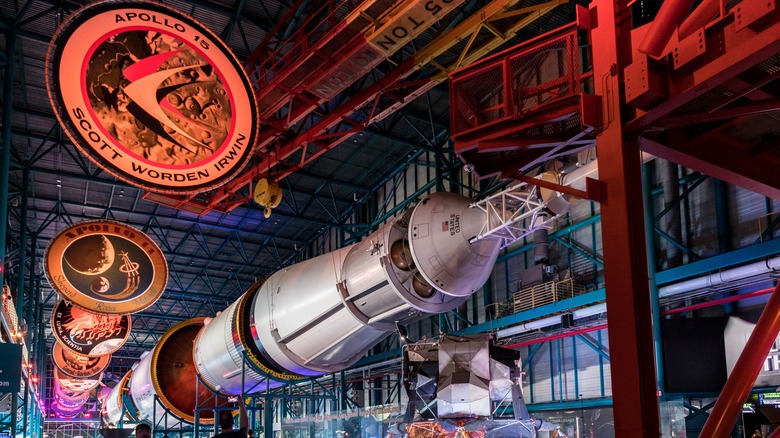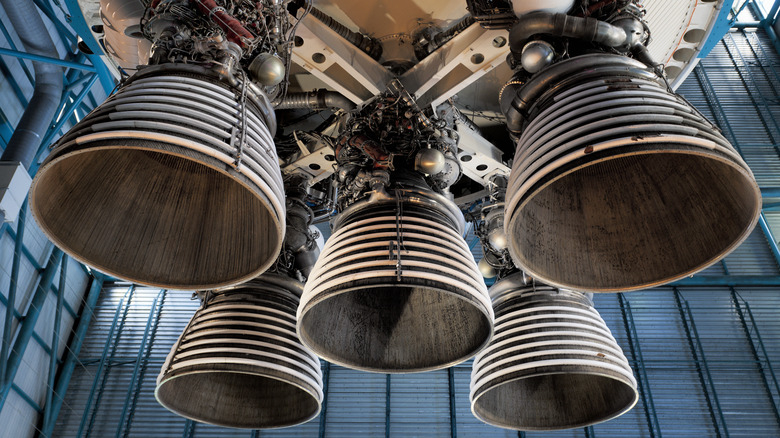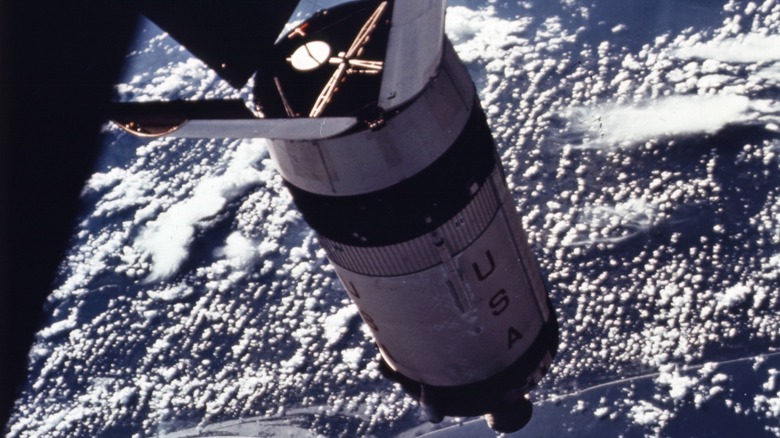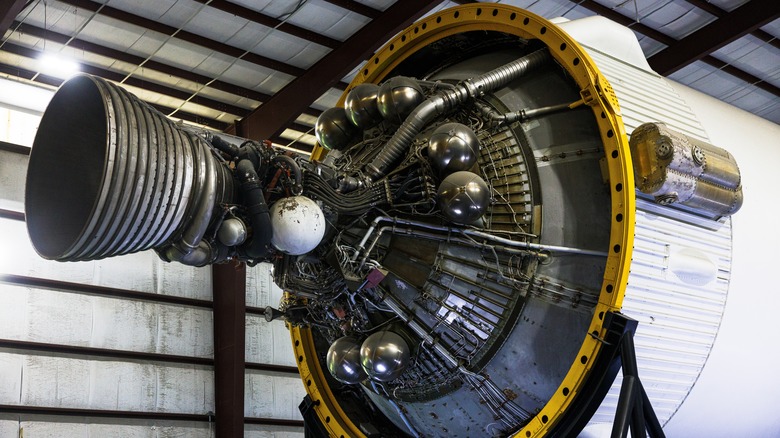What Engines Did Apollo 11 Use & Just How Powerful Are They?
The Apollo 11 astronauts used advanced technology to land on the Moon. The Saturn V rocket was the largest rocket ever at that point — although SpaceX's Starship topped it when it took flight in 2024. The rocket needed to be incredibly powerful to break from the Earth's orbit and blast off into space, sending a spacecraft 250,000 miles to reach the Moon. As of 2024, the Saturn V remains the only launch vehicle to carry people outside of Low Earth Orbit (LEO), and it carried a hefty payload.
The Saturn V's Rocketdyne J-2 engines had to push more than 300,000 pounds of propellant and gear, along with the Lunar and Service Modules plus the Apollo command crew. To achieve this, the Saturn V was outfitted with several engines, each providing thrust for one of the rocket's three stages. As each stage burned through its fuel, it was dropped and left to break up in the Earth's atmosphere on reentry. As this happened, the next stage took over, igniting its engines to continue the journey.
This technique remains a common practice, though some modern rockets developed by SpaceX are able to safely land its preliminary stages for reuse. The Saturn V didn't have this capability, so each mission effectively used up the rocket, requiring a new Saturn V to be built for the next mission. As of 2024, 13 Saturn V missions have launched from Kennedy Space Center in Florida, including the Apollo 11 mission launched on July 16, 1969.
Apollo 11's first stage had five engines
The rocket's first stage consisted almost entirely of propellant made from RP-1 fuel and liquid oxygen working as the oxidizer. The rocket's first stage was 138 feet tall and 33 feet in diameter, which was outfitted with five Rocketdyne F-1 engines. The central engine was fixed, but the four surrounding it could be moved to steer the rocket via hydraulically turned gimbals. These five engines provided 7.5 million pounds of total thrust.
Once launched, the center engine was shut off around 26 seconds before the engines surrounding it were. In total, the engines burned for only 168 seconds (two minutes and 48 seconds). After fewer than three minutes, the Saturn V's first stage propelled the rocket to an altitude of approximately 42 miles. The engines shot the rocket into the sky at a speed of 7,500 feet per second, or around 5,113 miles per hour. This amounts to Mach 6.72.
The F-1 engines mounted to the rocket's first stage packed a lot of power into a small area. They were fueled via a type of kerosene coupled with liquid oxygen. The rate of fuel consumption was a staggering 42,500 gallons per minute, so the first stage burned through approximately 119,000 gallons of fuel before shutting off its engines. Once finished with its burn, the first stage was ejected and allowed to fall back to the Atlantic Ocean, where it wasn't recovered.
The second stage also had five engines
Once the Saturn V's first stage finished its operation and was discarded, the second stage took over. This stage used a combination of liquid hydrogen and liquid oxygen instead of the kerosene mixture of its predecessor. However, the second stage was also equipped with five Rocketdyne J-2 engines, arranged in much the same way as the first stage to allow the central engine to remain fixed.
The second stage was shorter, measuring 81.6 feet tall with the same diameter of 33 feet. When fully fueled, the second stage weighed 1.06 million pounds and was responsible for accelerating the rocket through the upper atmosphere. Like the first stage, much of the second stage's mass was taken up by fuel — approximately 90%. It burned its engines for considerably longer at 395 seconds (over six and a half minutes). This pushed the rocket out of the atmosphere at 15,300 miles per hour, taking it to an altitude of 114.5 miles.
Once the second stage finished its burnout, explosive bolts would separate it from the remaining third stage. Once separated, it fired four retrorockets to decelerate the second stage to achieve a complete separation. After this, it was left to fall back to the planet where it burned up in the atmosphere. Once the remaining Saturn V components were clear of the second stage, the third stage took over for the final push toward the Moon.
The third and final stage just had one engine
The Saturn V's third stage was different from its predecessors in that it only featured one J-2 engine. Stage three utilized the same fuel mixture as the first stage, and it stood 58.4 feet high with a diameter of 21.7 feet. When fueled, the third stage weighed around 253,000 pounds. Another aspect of the third stage that made it different from the first two stages was that it was fired more than once. It first burned for 165 seconds (two minutes and 45 seconds) through Earth's orbit and then burned again to get to the Moon.
Part of the third stage met its end by crashing into the Moon, but the part to detach before that didn't completely fall into the planet and break up in the atmosphere. Some pieces were recovered, while other parts of Apollo 11's third stage orbited the Sun for decades before returning to Earth's gravitational pull.
All told, the Saturn V rocket boasted 11 J-2 engines, all of which held specific functions in achieving initial flight, orbital insertion, and travel to the Moon — where Neil Armstrong could utter his famous "one small step for man" line on the Moon. Additional retrorockets and the engines installed on the Lunar Module made it possible for the crew to return to orbit for their journey home.



